
Finding solutions to problems is a daily activity in both our professional and personal lives. However, it often happens that we are caught in dilemmas: should I rather be directive or participatory, should I focus on theindividual or team, do we have to be in the collaboration or competition…? There does not seem to be a direct, unique and lasting answer: this can then be a source of conflict.
This is where the Polarity Management by Barry Johnson enters the scene: he offers us an alternative approach by considering these dilemmas as polarities to be managed, for more empathy in our way of solving complex problems.
Want to know more ? Read on! 😉
Concept of Polarity Management

There are problems that can be solved and others that cannot be solved.
–Barry Johnson
Despite the apparent simplicity of this assumption, it is nevertheless extremely powerful from a strategic point of view.
Indeed, Barry invites us to distinguish 2 types of problems:
- Issue (to be resolved): having a solution that makes the problem disappear (choice of restaurant for lunch this afternoon, choice of the right dress to wear, etc.)
- Polarity (to be managed): having several possible solutions depending on the context (directive / participatory, individuality / collective, collaboration / competition, etc.)
Before going any further, let's define this second element a bit:
A polarity is a set of opposites that cannot function properly independently.
The 2 sides of the polarity being interdependent, one cannot choose one as a “solution” and neglect the other.
–Barry Johnson
The associated verb is important because it makes it possible to clearly understand the difference in operating mode:
- We seek to make the problem go away finding a solution, usually through careful analysis.
- We seek to modulate the problem by observing the effects of the polarity selected at a time t and by agreeing to switch to the other depending on the context.
Thus, we can say that the objective of Polarity Management is:
Obtaining the best from each opposite by limiting the disadvantages of each one.
| Note: We could draw a parallel with the Complicated and Complex domains of the Cynefin Framework. |
The main risk today would be to want to make a problem disappear by making a lot of effort to find the right solution when in reality it is more the responsibility of a polarity to be managed. To treat a polarity as a problem would also be to live unnecessarily long with the disadvantages of that polarity.
Problem (to solve) or Polarity (to manage)?

How do you know if you have a Problem (to solve) or a Polarity (to manage)?
The author shares 2 questions that can potentially help us:
Is the difficulty continuing?
- A problem has a solution that will make it disappear, it is an end in itself.
- A polarity doesn't really have a solution, we are more or less always in the process of resolving it: that's why we use the term “manage” by the way.
Are there 2 interdependent poles?
- A solution to a problem can be unique and live on its own. It doesn't need an opposite to function over time.
- A polarity needs to switch from one opposite to the other, because neither of the 2 poles can suffice alone. They need each other.
Here are 3 examples to illustrate the use of these 2 questions:
| Type of difficulty | Example | Continuing difficulty? | Interdependence of the 2 poles? | |
| 1 | Problem (Decisions in OR) | Choosing a restaurant for lunch | No : when the choice is made, the problem disappears | No : the 2 choices do not depend on each other and do not need each other to exist |
| 2 | Problem (mysteries to solve) | How to go to the moon? | No : despite the research time, the answer eliminates the problem | No : the alternatives are mutually exclusive and do not depend on each other to exist |
| 3 | Polarity | Juggle | Yes : Keeping a ball in the air is a continuous challenge | Yes : we really need a hand that throws and another that catches and we really need the 2 movements so that the process continues to work |
Here are some examples of common polarities:
| Cost | Quality |
| Market driven | Product driven |
| Centralization | Decentralization |
| Innovation | Standardization |
| Autocratic Management | Participating management |
| To plan | To act |
Manage polarities with the Polarity Map
The Polarity Management approach is based on a very simple tool that Barry Johnson calls: the Polarity Map.
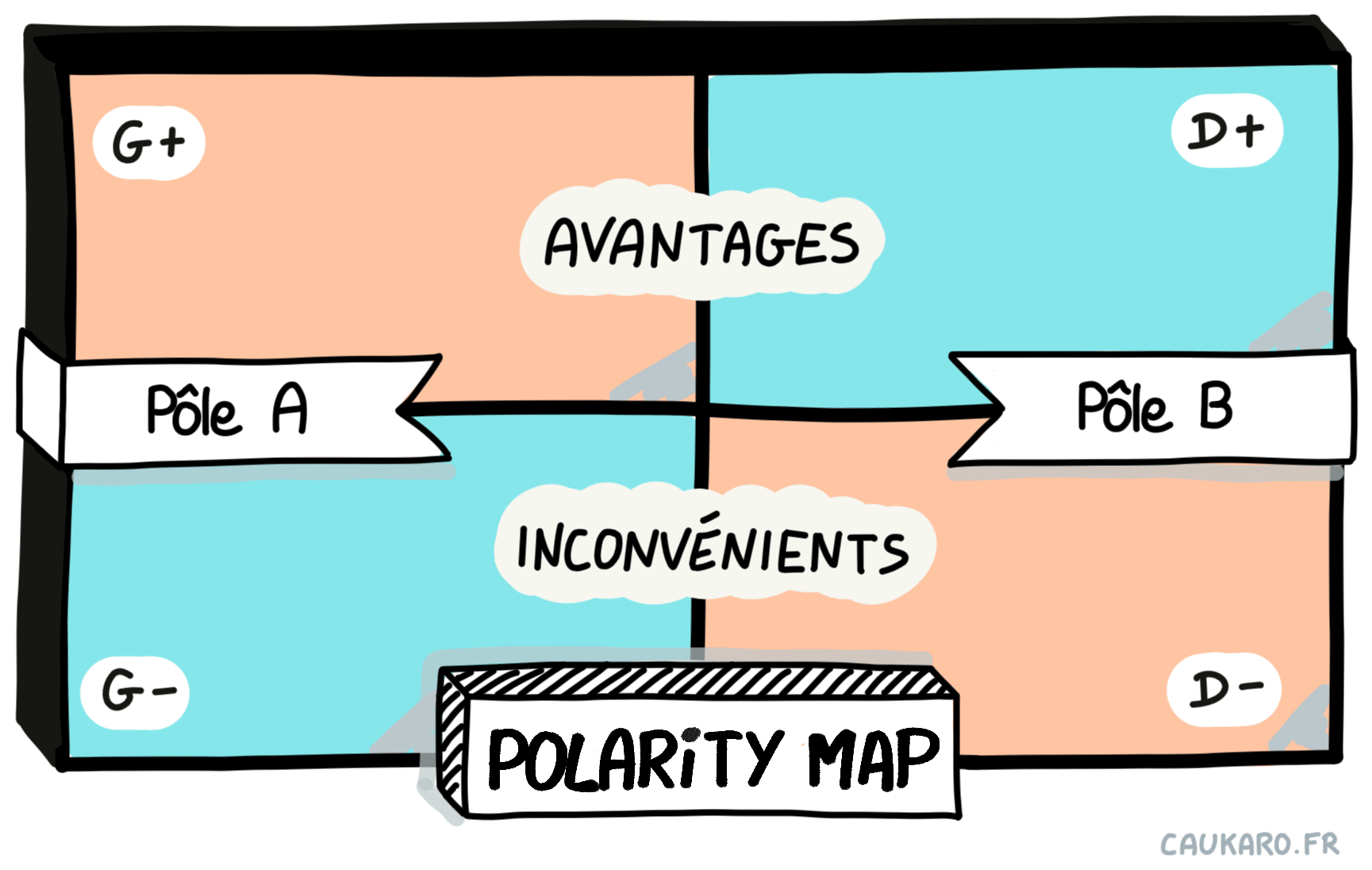
Its structure is as follows:
- the 2 poles of the studied polarity are represented on a horizontal axis
- the advantages and disadvantages on a vertical axis
We will then fill in for each quadrant:
- G+ : the Advantages of the Left Pole
- D+ : the advantages of the right pole
- G- : the Disadvantages of the Left Pole
- D- : the Disadvantages of the Right Pole
We then find ourselves with 4 very distinct quadrants that it is important to clearly visualize in order to be able to manage a polarity effectively.
Dynamics of polarities
Barry Johnson describes to us what he calls the 2-step dynamics of polarities:
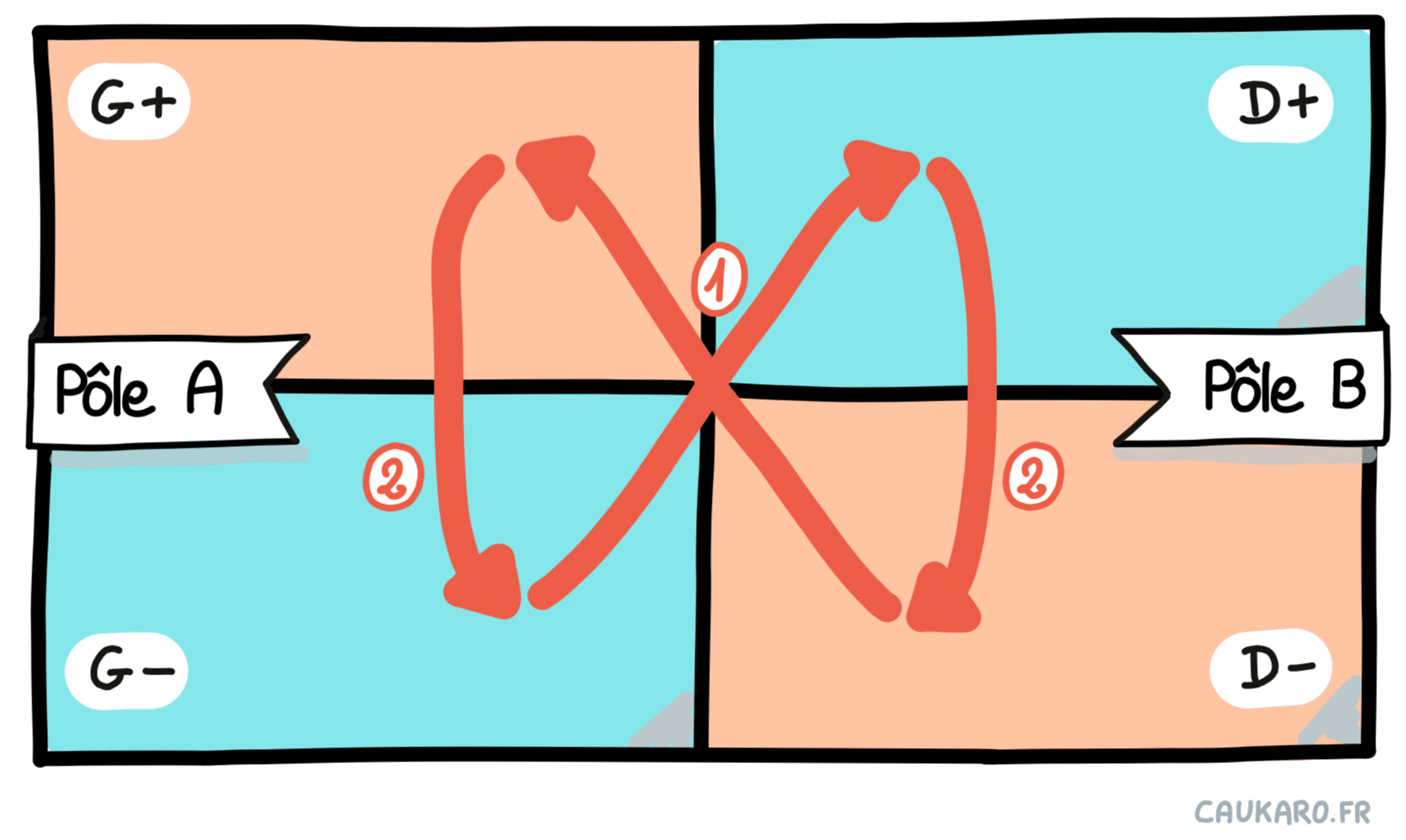
- Diagonal Up : we seek to free ourselves from the disadvantages of the pole in which we find ourselves by seeking the advantages of the other pole
- Down : we are beginning to experience the disadvantages of the pole in which we are now
And we start again.
We then go through the 4 quadrants to finally return to where we started.
| Note: An "infinity" symbol is then drawn, representing a continuous and permanent movement of the process. |
Let's take a simple example with the breathing process:
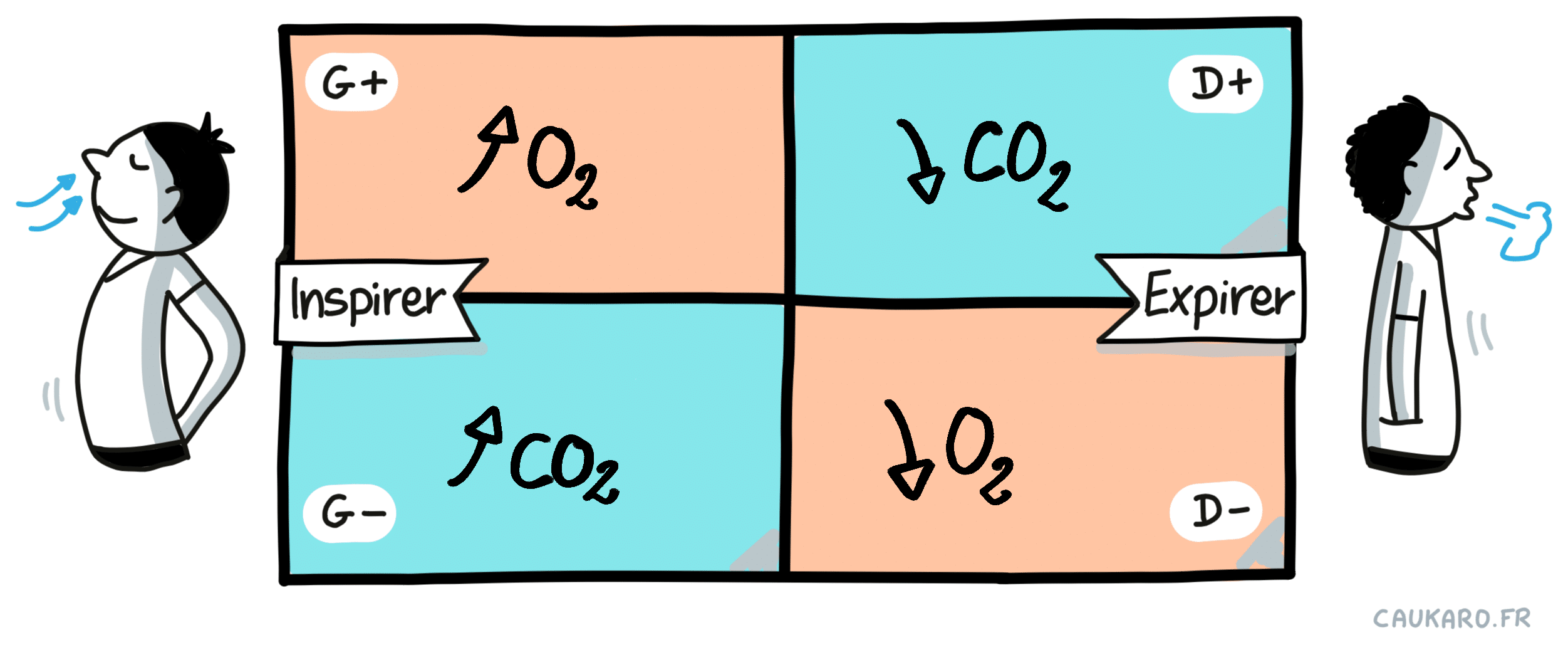
In this case, the 2 poles we are studying are inspiration and expiration.
Let's start for example from the frame G- :
- Towards D+ : As inspiration generates a surplus of CO2 in the body, we switch to the other pole to reduce the quantity of CO2 through expiration.
- To D- : However, by staying in this pole, we will start to feel that we are lacking in O2.
- To G+ : This will require switching to the other pole in order to recover from it by inspiration.
- Towards G- : Now, by staying in this pole too long, we will generate a surplus of CO2 in the organism and we return to the first stage.
I find that this example is both simple to understand and highlights the notion of interdependence of the 2 poles: indeed, it would not occur to you to keep only the inspiration or the expiration in your breathing process isn't it? 😛
The difficulty lies in the perception that we have of a problem that can be solved by choosing one or the other of the solutions.
Depending on how we perceive the problem, our interpretation of what is happening will differ:
- If we consider that it is a Issue (to solve) :
- a solution that does not work will be called an “error”
- we then fear remaining stuck in the other pole without the possibility of turning back – we then remain stuck in our pole, suffering all the more its negative aspects.
- If we consider that it is a Polarity (to manage) :
- switching from one polarity to another is part of the process
In effect :
To benefit from and maintain the advantages of a pole, we must pursue also the advantages of the other pole.
We then wish complement a model of thought OR with a model of thought AND.
Accuracy and Completeness

You may already know this famous optical illusion above? There are 2 women in this image, do you see them?
While talking about Polarity Management to my colleagues during a lunch, we lingered on this image that one of them did not know.
Here is an excerpt from the (arranged) exchange we had:
Me : What do you see in this picture?
Colleague A : I see a young woman.
Me : Nothing else ? What if I told you there was also an old woman?
Colleague A : I don't see it, but I trust you enough to believe it exists!
Colleague P : Would you like me to help you see it?
Colleague A : Yes ! THANKS !
I found this situation very representative of the nuance between accuracy and completeness. Indeed, my colleague A was just to say that he saw a young woman but his vision was incomplete.
It is the incompleteness of the perception combined with the conviction of correctness that is the source of potential conflicts.
–Barry Johnson
In case the colleague P saw only the old woman, you could say that they were both "fair". However, that's the easy part. The hardest part is seeing the alternate image.
If so, there are different ways to communicate about it:
- THE colleague A could have said "the old woman is not here", contradicting the correctness of the reality of the colleague P, thus generating unnecessary resistance and potentially conflict.
- THE colleague A finally said " I do not see her ", arousing the help and empathy of the colleague P to complement his vision with the alternative image.
| Note: the climate of trust between us probably helped in the situation but I suppose you could find examples where it does not happen so easily! 😉 |
To contradict the correctness of the other's reality is to generate unnecessary resistance.
–Barry Johnson
Give up a moment to get more

We study here a concept of psychology Gestaltist named the figure-ground perception which tells us that:
All perception would be divided into a foreground (figure) and a background (ground).
This amounts to saying that our perception is reduced at a moment t to only one piece of the whole. If we leave it at that, we may never see all of it.
An example described by the author is to look at a landscape through the window: when we see the landscape clearly, the edges of the window are blurred, but by releasing our attention to focus on the window, it is reverse that occurs.
In the case of an interaction like the one described above, we see that no one needs to give up what he/she perceives at first. (Confirmation of correctness).
Confirming correctness increases the possibility of complementing one view with another view.
–Barry Johnson
However, he is asked to complement his view with a second view which is also true. For this, you have to be able to let go of the figure to let the background take its place. This does not mean denying what we saw, but not putting the center of our attention on it, at least for a moment in order to give ourselves the opportunity to discover more.
Moreover, once you have the 2 visions, it becomes easier to switch from one to the other. It's just not possible for us to have both at the same time.
We can both be fair: our apparent opposition can then become a common resource.
We have the possibility of deciding to put our vision aside for a moment to put our efforts to see that of others. Indeed, it is easier to expand one's view than to get those with an opposite view to expand theirs. This responsibility belongs to us and commits us to more empathy for others.
Crusade and Tradition
In any polarity – which could also be called a “dilemma” – there is an ongoing dynamic tension about switching to the opposite pole, when and how to do it. We then find 2 forces in presence: the forces in crusade and the guardians of the tradition. Let's see together what they return to.
Crusading Forces
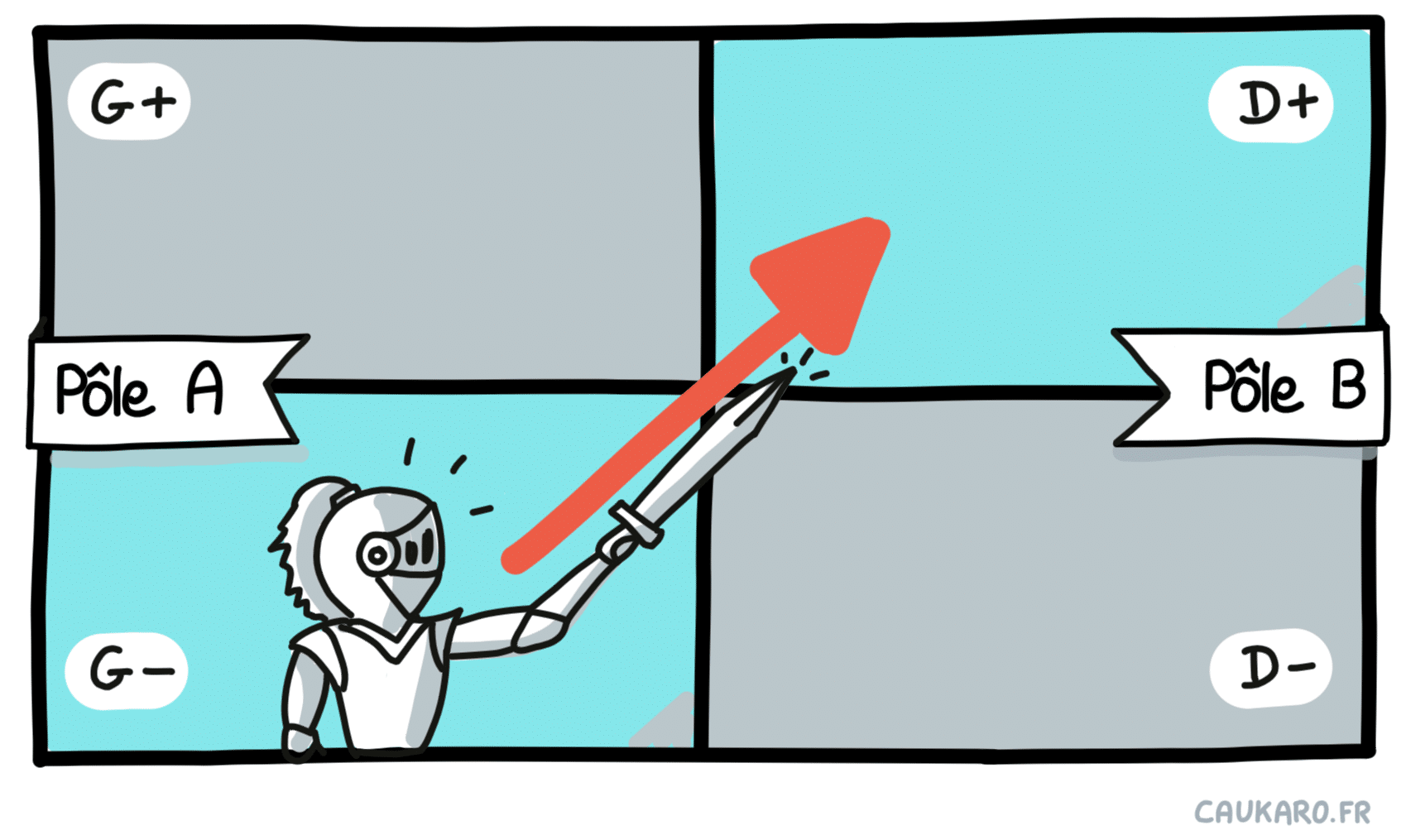
The crusading forces are the people who want to leave the disadvantages of the pole in which they find themselves to seek the advantages of the opposite pole. If we take up the notion of figure/ground perception, it is then the 2 quadrants with opposite diagonals that are at the center of attention. Barry Johnson then warns us:
The greater the difference in clarity on the content of the 2 sets of diagonal quadrants,
the more one person will feel right and the other wrong.
–Barry Johnson
Indeed, taking the example of the polarity Individual Focus (Pole A) / Team Focus (Pole B), if those fighting for Team Focus:
- are very clear about the disadvantages of Focus Individual (G-) and benefits of Team Focus (D+),
- and very vague on the advantages of Focus Individual (G+) and disadvantages of Team Focus (D-),
Then they will be convinced that they are right and that their opponents are wrong.
It is therefore easy to imagine that these people, blinded by the ideal of the situation of the opposite pole, can feel in their full rights and frustrated by any opposition.
Now, it's important to keep in mind that these crusading forces are critical to the health of the system. Indeed, it is the agents of change who provide the energy needed to change when the situation becomes critical. Ignoring them or preventing them from acting would be damaging in the short term and probably costly in the long term.
The keepers of tradition
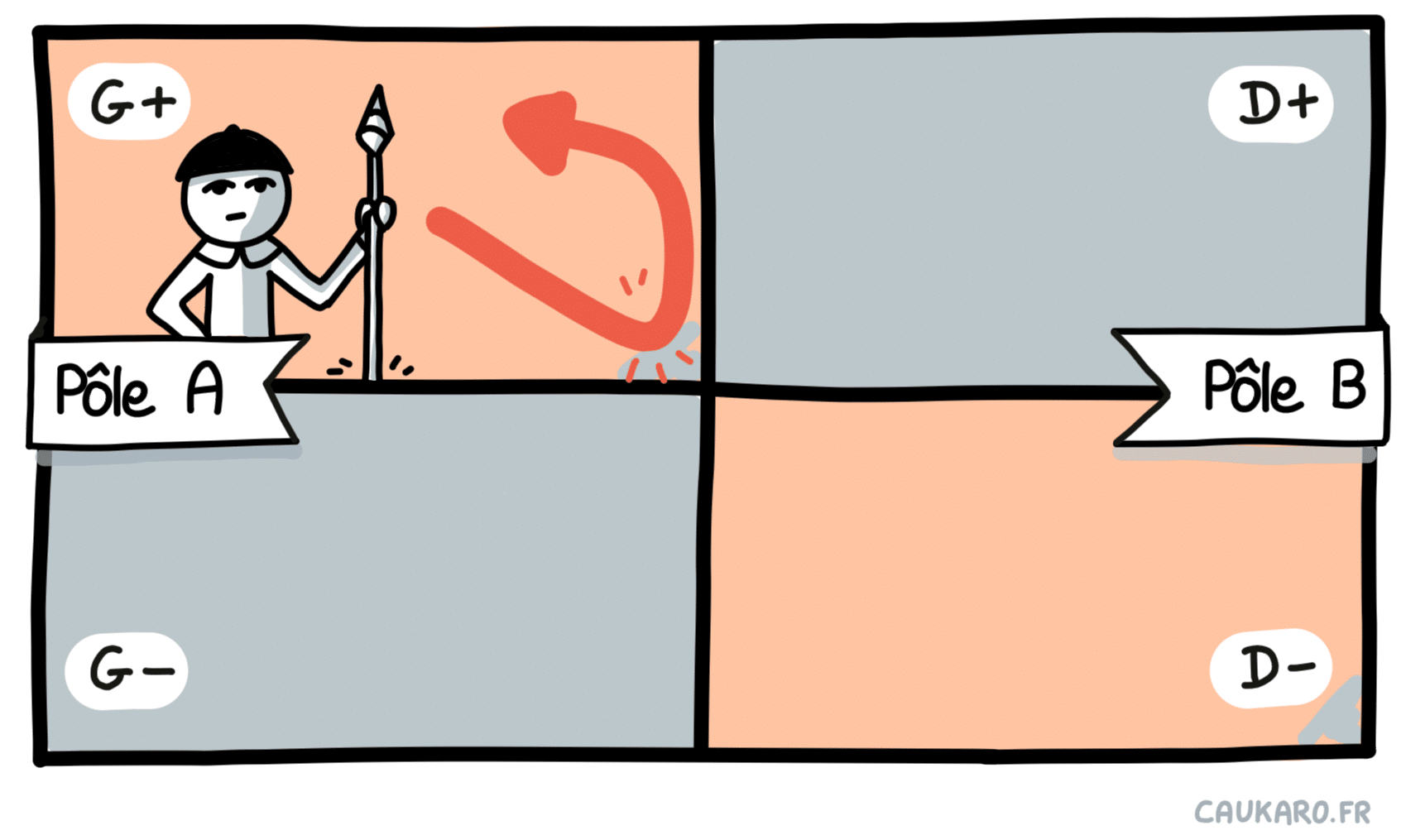
In any desire for change, there will be people considered “resistant”: they are our guardians of tradition. More than simply “resisting” the pole shift, they will highlight and preserve the best of the current situation. In their case, what works as a figure is the set of diagonal quadrants opposite to that visible to the crusading forces. Going back to our previous example of polarities, the tradition keepers for Individual Focus:
- will value the advantages of the Individual Focus (G+) ,
- and be terrified of falling into Team Focus disadvantages (D-)
Which easily explains why they will prefer to turn back and stay where they are. We have here the same reasoning as for the forces on the crusade: the greater the difference in clarity of the guardians of the tradition on the content of the 2 sets of diagonal dials, the more they will have the impression of being right and that the forces in crusade are wrong. Now they are also essential for the health of the system. Indeed, they are those that allow the organization to best cultivate what is already working well to preserve the advantages of the current situation. As with crusading forces, it would be a shame to ignore them in the short term and probably costly in the long term. We then understand that we need these 2 forces present in order to be able to manage the polarities as well as possible. Indeed, they both contribute to having a complete vision of the situation by filling in the 4 quadrants of the Polarity Map.
An effective crusade
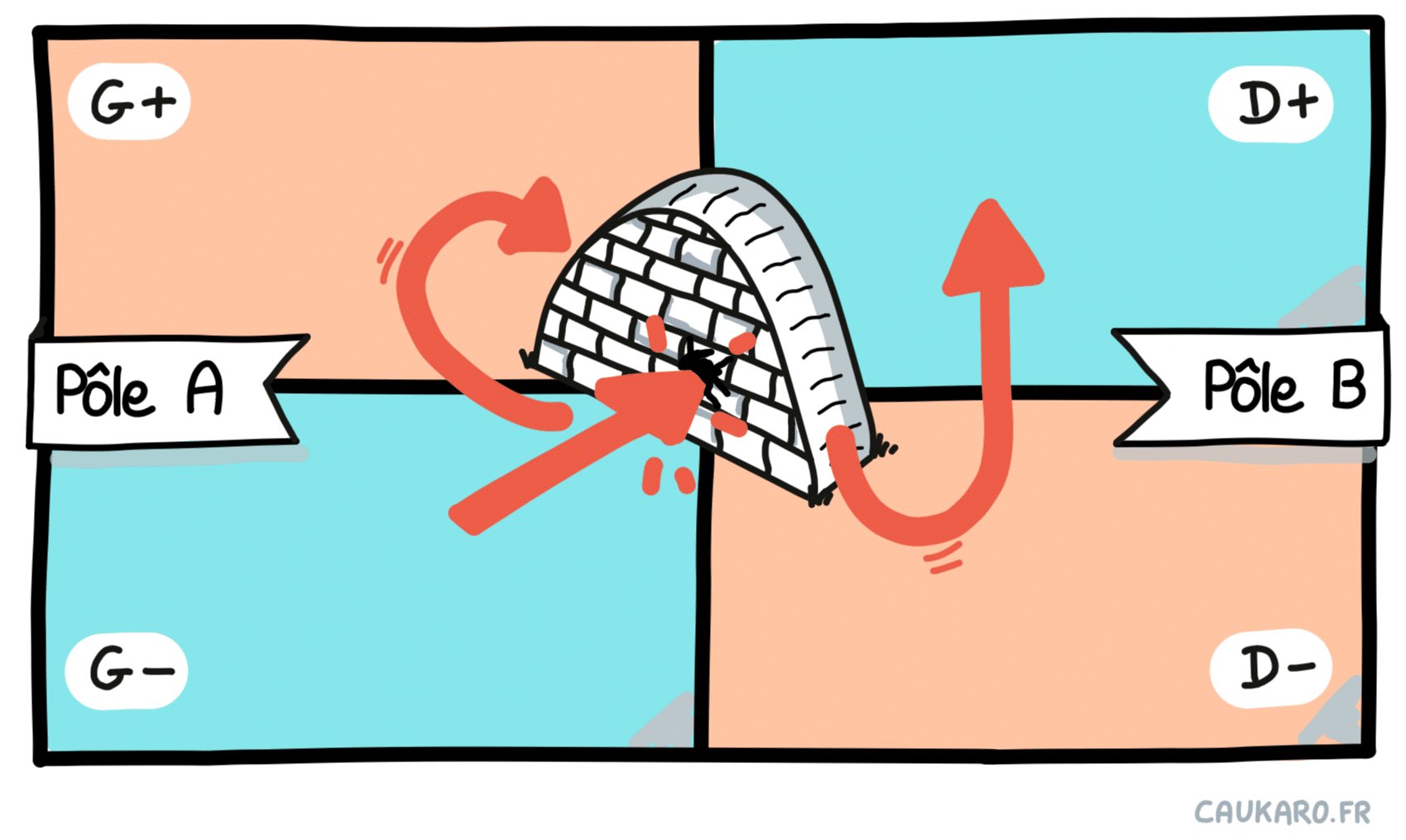
Instead of increasing the pressure against the wall, make it a bridge.
–Barry Johnson
Let's say I'm part of a crusading force.
I seek to promote change and I encounter resistance. I understand that this is not a Problem (to be solved) but rather a Polarity (to be managed). From this perspective, I then accept that this apparent opposition can also become a common resource.
As a crusading force, I more naturally see the negative aspects of the current situation (G-) and I have a pretty clear vision of how we could fix it (D+). I also know that this clarity is actually only half the picture. To be able to manage this polarity correctly, I therefore have to fetch the content of the other 2 missing quadrants: the advantages of the current situation (G+) and the disadvantages of the opposite pole (D-).
It is by listening to the keepers of the tradition that I could obtain them. Indeed, I know that the sources of resistance come from their fears of losing the advantages of the current situation. (G+) and get the disadvantages of the opposite pole (D-). They have metaphorically built a wall between their 2 fears.
Because of this wall, one cannot follow the usual movement. So rather than increasing the pressure against the wall, let's make it a bridge to include that wall in the process of getting where you want to go.
By doing this, we will pass through the 4 quadrants in the opposite direction of the usual flow: (G-) towards (G+) towards (D-) towards (D+).
How does this help us to carry out an effective crusade?
By going in the opposite direction of the usual flow, one will not only join the resisting forces by looking at their reality first (G+) but we will also go in the direction of their energy. This actually leads us to take the time to listen to their points of view to include them in the process.
We can then potentially end with (G-) instead of starting there. This seems like a much more effective strategy for conducting a crusade from a polarity management perspective.
This may appear as a paradoxical approach to change:
The easiest way to get the benefits of the collective (D+) when meeting resistance is to identify the benefits of individuality (G+) and recognize the limits of the collective (D-).
Effective maintenance of tradition

The process here will be broadly similar as for an effective crusade:
Start by clarifying your own perception of the reality of the other before working to convince them of your own.
Instead of starting with the benefits of Individuality (G+) to then go to the disadvantages of the Collective (D-), we can start with (G-), to go to (D+) Then (D-) to finally go (G+).
Now that we know that to manage a polarity, we will have to switch from one pole to the other as needed, it is important that we have a good view of the 4 dials to get the complete picture. So the idea is to listen and understand what the crusading forces have to say: the downsides of the current situation (G-) and advantages of the opposite pole (D+)
As a lore-keeper, one not only joins the crusading forces trying to see their reality first, but one also moves through the dials in the direction they are pursuing. The objective is then to join the crusading forces and challenge them at the same time.
Joining them means recognizing that there is a polarity to manage: ensuring that the advantages of the current pole are not lost and that the disadvantages of the other pole are not ignored.
Case study: Tension between a manager and his team
Imagine a team of workers complaining about the behavior of their manager:
He has an overly directive style of management. He micro-manages us and this prevents us from taking initiatives! In addition, it makes us waste a monstrous time rather than dealing with what is important! (Issue)
He should be more flexible and trust us more! This would allow us to move forward together by adjusting more easily to situations. (Solution)
Let's represent this as a Polarity Map:
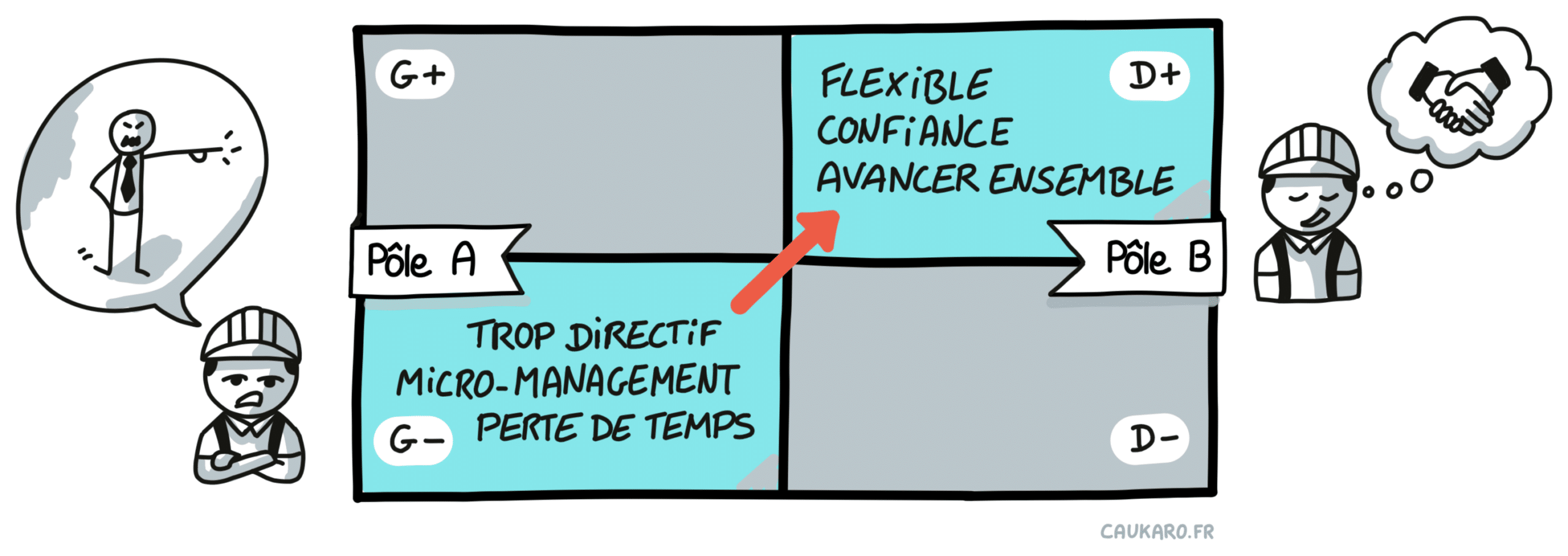
Our workers here are our crusading forces. By confining oneself to this vision, it is difficult not to converge with them towards their conclusion!
Now, let's see what their Manager tells us:
It is important for me to have visibility and to be clear on the direction. I want my employees to feel safe and to know where they are expected. (Solution)
I fear that by letting go by giving them more freedom that they will feel lost because of the ambiguity of the framework or that it will generate chaos! (Issue)
Let's represent this as a Polarity Map:
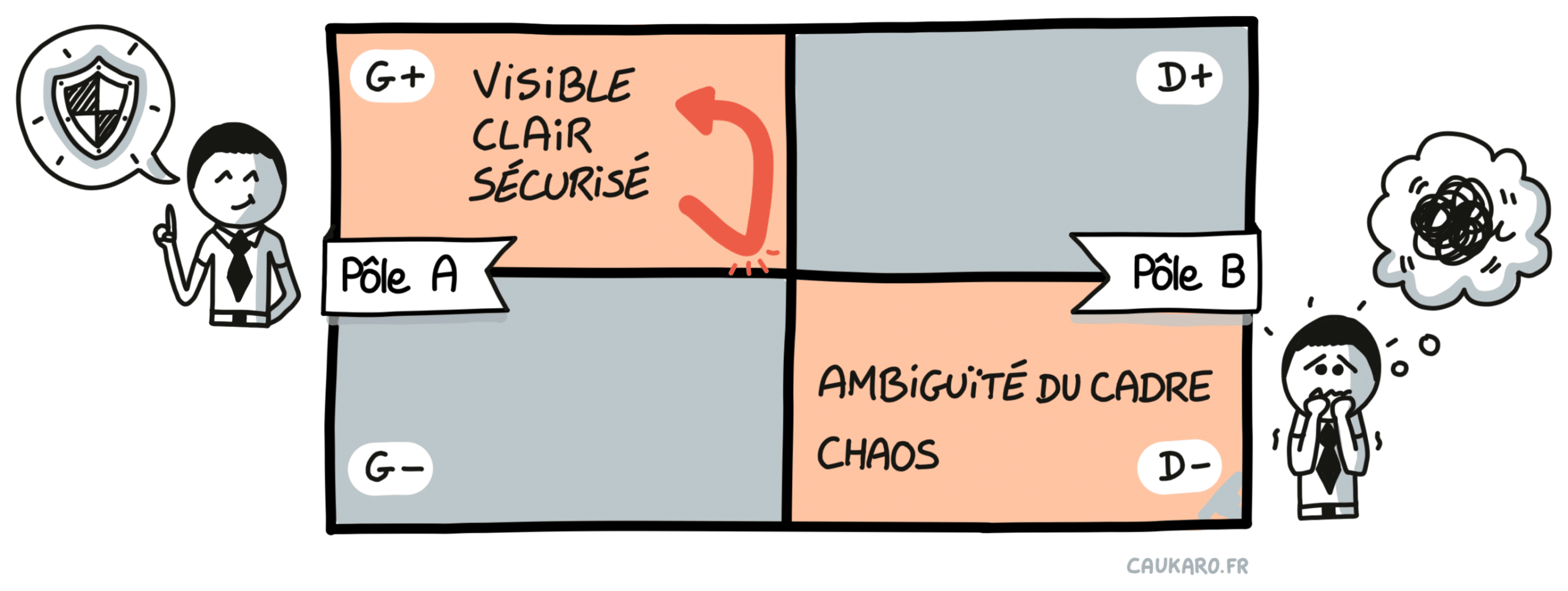
Our Manager is our guardian of tradition here. By confining oneself to this vision, there is no doubt that no one would venture to the other side of the precipice!
We are therefore in a Polarity (to be managed) and not a Problem to be solved). Let's then build a Polarity Map bringing together these 2 points of view to obtain a more complete picture of the situation:
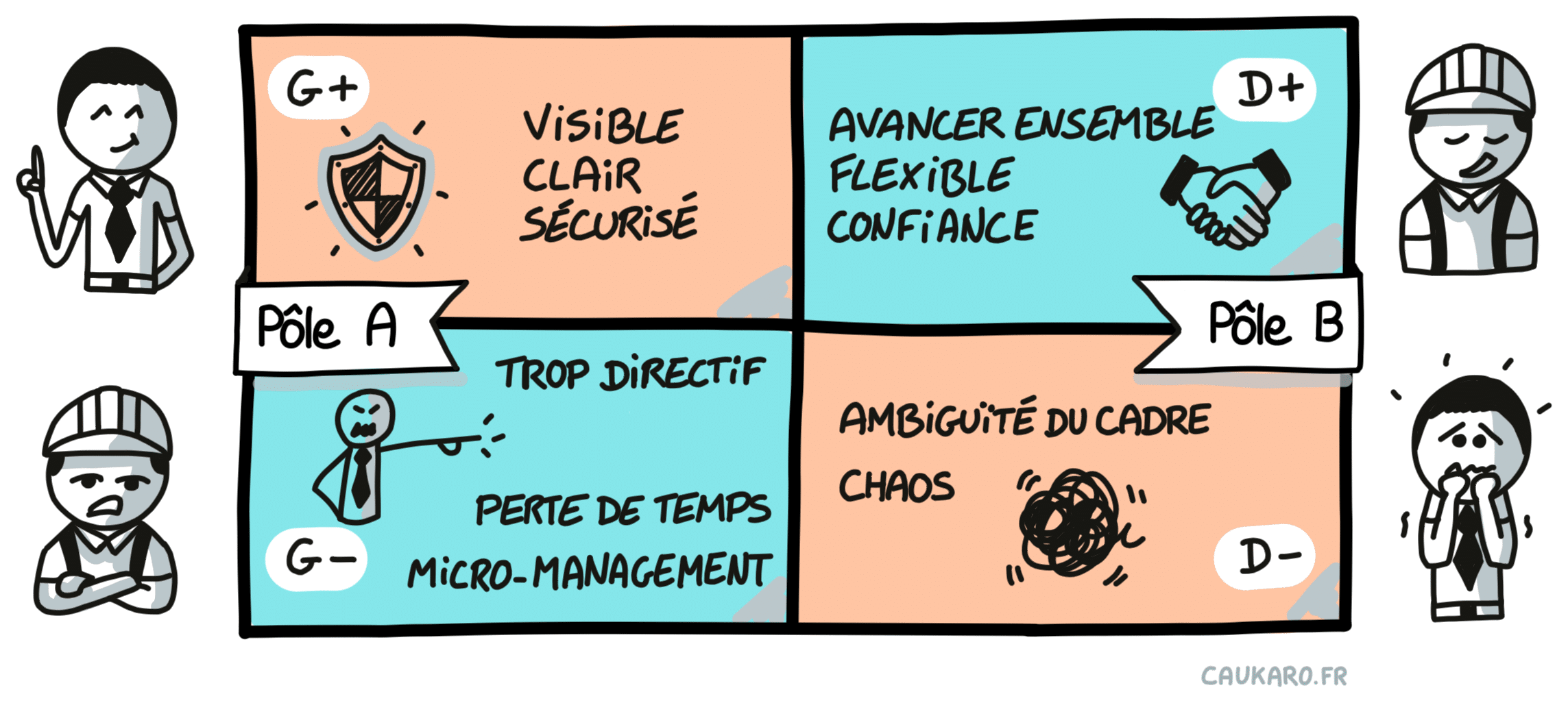
It is by having created this more complete vision that we can try to satisfy the whole. Indeed, this Polarity Map allows both workers to understand their leader's position and the fears that prevent him from changing his way of doing things and both the leader to understand the disadvantages of his current posture and what he could tend to remedy it. We see that the issue is above all a problem of perception: by clarifying it, this allows us to be more open to discussion in order to find a suitable outcome for everyone at a given moment.
| Note: in this example, the naming of the 2 poles was not necessary. Indeed, I have always found it difficult to find the names of the polarities! In my opinion, what matters is above all the filling of the 4 quadrants and the highlighting of the complete vision in the different parts. |
To properly manage a polarity
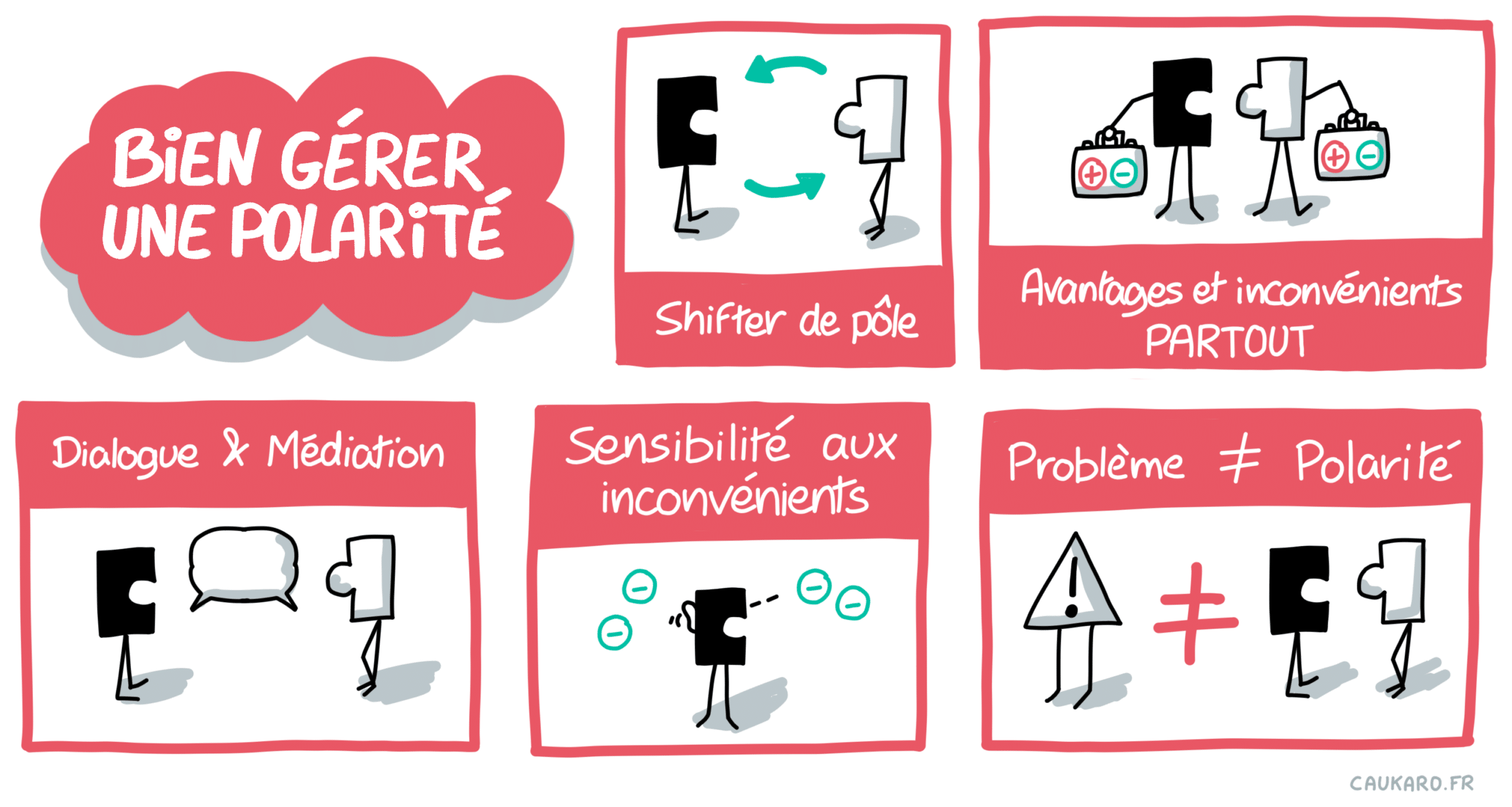
| PRACTICE | GOALS |
| Differentiate a Problem (to solve) a Polarity (to manage) | to be able to implement the right strategy |
| To understand that there are Advantages (+) and Disadvantages (-) in each pole | to try to get as complete a picture as possible |
| Have a Sensitivity to Drawbacks (-) as they are lived | to develop empathy for others |
| Shifter pole as needed | to get the best from each pole by limiting their disadvantages |
| Talking to opposites and mediating between opposites | to include all the forces involved in the process |
Conclusion
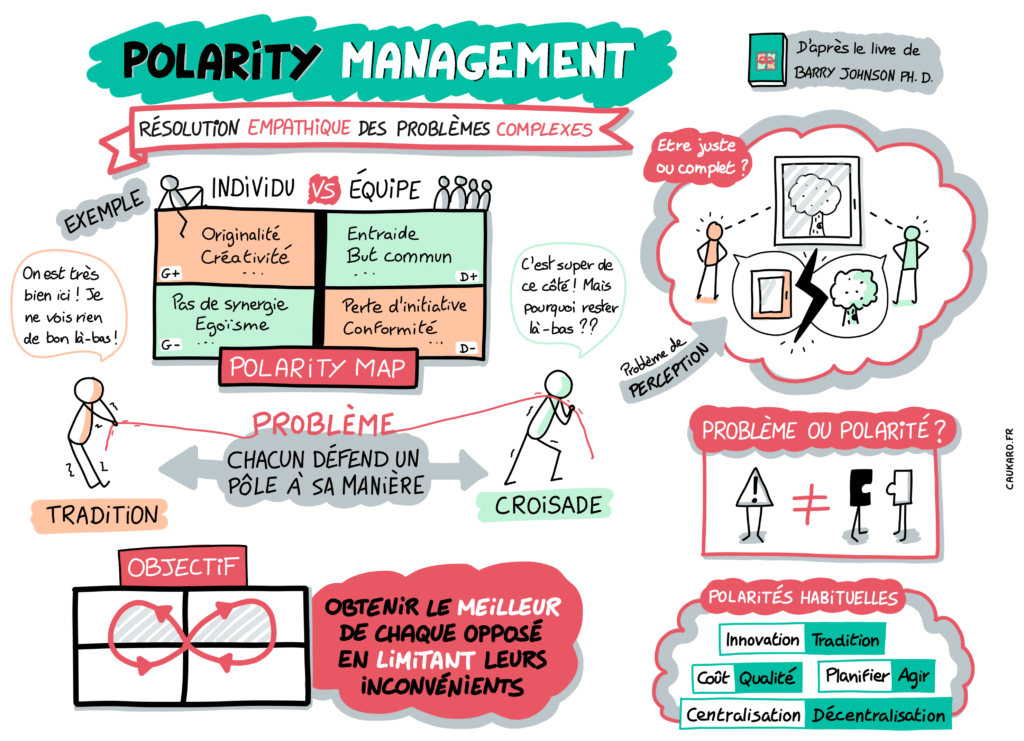
Polarity Management is an interesting approach to solving complex problems – which Barry Johnson calls Polarity. The author invites us to seek a more complete vision of the situation by going to discover in the other a complementary vision.
I think that's the heart of the matter: when a problem seems insoluble, the important thing is not to know who will be right but rather how we can overcome this difficult moment together! 🙂
Hoping that this article will have piqued your curiosity, I wanted to thank Irene Doan for introducing me to the subject!







3 responses
Hello Oliver,
Thank you for this article, the subject is fascinating, it's the kind of reflections that make a click, we're dealing with it, we feel it, we don't put a name on it and when we see it exposed like this everything lights up 🙂
I would add that the infographics are really good and further add to the clarity of the explanations, congratulations to her!
Bonjour, je souhaite participer au prochain atelier. Merci.
Voici mrs coordonnées ; belhacenej@yahoo.fr
06 72 90 16 44.
Jamel.